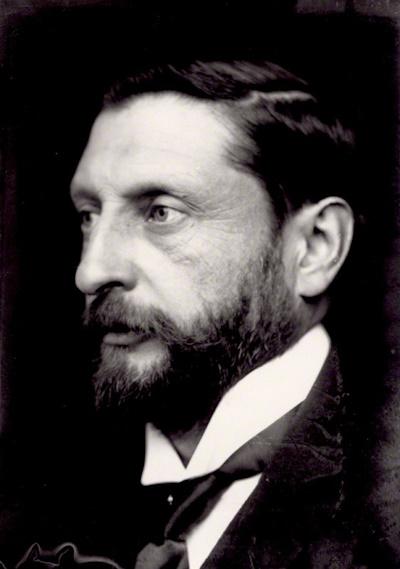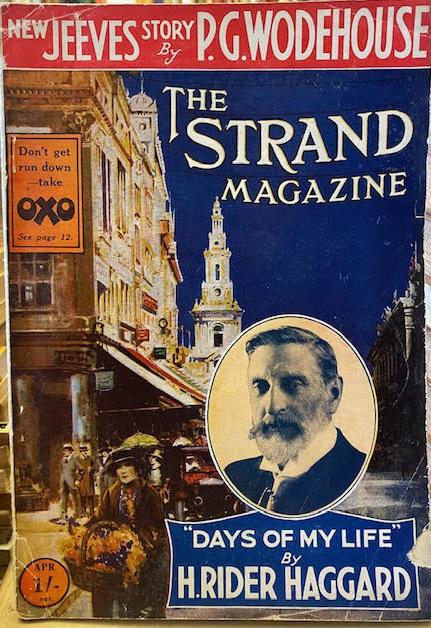Book Review by Sue Roe: Rider Haggard was prompted to write his autobiography by a rather bizarre occurrence:
A while ago, it may have been a year or more, the telephone in this House rang and down the mysterious wire… came an excited inquiry from a London press agency, as to whether I were dead. Before this event happens to me …it has entered into my mind that I desire to set down, while I still have my full faculties, certain of my own experiences of life
It was published in two volumes – I only read the first. Initially he set out the details of his early life: He was not academically able:
I fear that I was more or less of a dunderhead at lessons
. On one occasion, after an abysmal performance in a test, his father roared out at him that
I was “only fit to be a greengrocer.” Even then I wondered why this affront should be put upon a useful trade.
His father, having spent a lot of money on private school fees for Haggard’s older brothers, decided to send him to be tutored by the local rector, and then to Ipswich Grammar School. He failed the entrance for the Army and was then sent to a crammer in London to prepare for the entrance exam for the Foreign Office.
To this end, when I was just eighteen, I was put in lodgings alone in London, entirely uncontrolled in any way. At this age I was thrown upon the world, as I remember when I was a little lad my elder brothers threw me into the Rhine to teach me to swim. After nearly drowning I learned to swim, and in a sense the same may be said of my London life….
He never took the exam. His father wrote to a family friend Sir Henry Bulwer asking if there was an opening for his son Henry. Bulwer was going to Natal as Lieutenant Governor and so, at the age of nineteen, he was sailing to South Africa as Bulwer’s secretary. He later worked for Sir Theophilus Shepstone, Special Commissioner for the Transvaal. Then, aged twenty one, he became Registrar of the High Court in the Transvaal. In these roles he was able to witness at first hand important events in South Africa: the Annexation of the Transvaal, the British defeat by Zulus at Isandlwana, Majuba- the final battle of the First Boer War which culminated in Transvaal been given back to the Boers.
 Rider Haggard in 1902. (Wikipedia)
Rider Haggard in 1902. (Wikipedia)
He had returned to England on the dismissal of Shepstone, got married and then the couple went back to Africa where he worked as an ostrich farmer. In 1882 they returned to England for the last time at the Recession of the Transvaal.
Out of a job, he studied for the Bar though he didn’t practice much. He spent a lot of time writing with not much success:
Three works had I produced, namely, one history and two long novels. The history had cost me 50 pounds to publish, and for the two novels I had received exactly the same sum in all; in short, the net returns were at that time nothing!
After this limited success, he nearly threw in the towel.
… Had it not been for a curious chance my literary efforts would have ended with the publication of “The Witch’s Head,” and probably by now my labours at the Bar in this or some other land would almost have obliterated them from my memory. But, as it happened, I read in one of the weekly papers a notice of Stevenson’s “Treasure Island” so laudatory that I procured and studied that work, and was impelled by its perusal to try to write a book for boys.
The result was King Solomon’s Mines (1885) which was an instant success. Other successes followed.
Volume One finishes with his trip to Iceland. He was planning to write a Norse saga and wanted some background material
He quotes many of his letters in the course of this book: letters to and from his family, letters to and from the men for whom he worked. He was a close observer of people and events: he writes at length about his bosses, his job, the events he witnessed and the natives he encountered. He had a great sense of duty and patriotism ; he was loyal and faithful, angrily defending Shepstone when the latter left South Africa under a cloud. He often mixed with older men –his bosses; their mutual high regard is evident in the letters he quotes.
In a letter to his mother he describes a witch finding, details of which he used to great effect in King Solomon’s Mines. He picked up a lot of details about Zulus and their way of life from a translator. He even reveals that two characters from his novels, Umslopogaas and Allan Quartermain, were real people. Much later Umslopogaas heard that Haggard had written about him so asked for half of the profits!
I took the hint and sent him, not money, but a very fine hunting-knife with his name engraved upon it.
He often writes sympathetically about the Zulus and other tribes, both in his novels and this autobiography. He defended the refusal of Kaffirs to work down the mines for low wages:
Surely the Kaffir whose land we have taken has a right to follow his own opinions and convenience on this subject?
He believed that true gentility was “not the prerogative of a class but a gift innate”
He writes fluently; his descriptions of scenery and native rituals are vivid and colourful. He knows how to “tell a good tale!” It is true that his views are very much of his time and class: he is a staunch defender of the Empire and the superiority of England. He did not like the Boers much on first meeting but learned that there was much to admire in the Boer character.
I did find the political events in South Africa a little difficult to follow at times so had to do some research on the Zulu Wars & the First Boer War. Also I think the letters could have been edited as he does quote them in too much detail which isn’t always necessary.
He can digress from the narrative at times. He writes at length, again via long letters, the efforts he made to dissuade a friend from joining a Trappist monastery. Similarly he describes the views of the controversial Bishop of Natal, John Colenso who advocated rights for the natives and defended their practice of polygamy. Haggard seemed to agree with him on the latter.
I enjoyed reading the first volume of his autobiography though perhaps not enough to progress to the second!
 The book was originally serialised (posthumously) in the Strand magazine.
The book was originally serialised (posthumously) in the Strand magazine.
